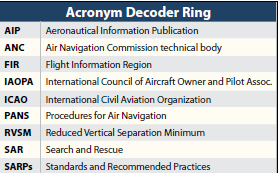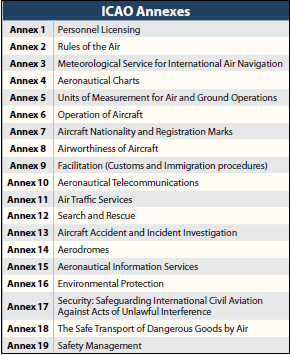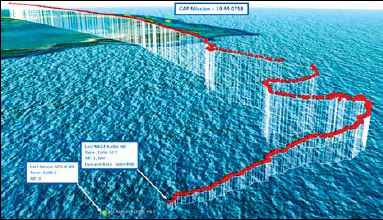The International Civil Aviation Organization (ICAO) dwells in the deep recesses of general aviation operations. We now file ICAO flight plans, only vaguely aware that ICAO is some wispy regulatory body that seems to have the pull to make it happen. ICAO does indeed have major chops. Formed in 1947, it is one of the United Nations’ 15 specialized agencies that perform tasks requiring worldwide coordination. The ICAO Assembly has 193 member nations, excluding only countries like Lichtenstein, which have no international airport. ICAO alone is vested with international aviation authority.
Inside ICAO
Headquartered in Montreal, part of ICAO’s charter is to create rules governing international air navigation. Although air transport is its central focus, ICAO is fully aware of GA. Do we have any pull? Yes, we do. More on that later. Thirty-six member countries form ICAO’s political component, the ICAO Council. The U.S. is one of 11 members of “chief importance.” The Council adopts Standards and Recommended Practices (SARPs) for inclusion in one of 19 Annex subjects (see the table). ICAO’s technical body, the Air Navigation Commission, is responsible for 17 of the 19 Annexes. The ANC has 19 technical commissioners, all chosen from member nations. Commissioners are apolitical in the sense that they do not represent their countries. Under their leadership, 17 ICAO Panels develop SARPs. Each panel is mainly in charge of one Annex. Proposed SARPs move up the chain to an ANC commissioner, then the ICAO Council for consultation with member nations before final adoption into Annexes. The process takes about two years.  After some heavy-duty research and a few false starts (see the first sidebar), the ICAO Phonetic Language (Alpha, Bravo, Charlie, Delta…) was adopted in 1956, before the Federal Aviation Agency was born in 1958. ICAO flight plans, “Line up and wait” (replacing “Position and hold”), and renaming the Airport/Facility Directory as the “Chart Supplement U.S.” all help make our domestic operations consistent with global practice. Similarly, all ICAO countries must issue the English Proficient endorsement, which applies if the pilot plans to fly outside their home country.
After some heavy-duty research and a few false starts (see the first sidebar), the ICAO Phonetic Language (Alpha, Bravo, Charlie, Delta…) was adopted in 1956, before the Federal Aviation Agency was born in 1958. ICAO flight plans, “Line up and wait” (replacing “Position and hold”), and renaming the Airport/Facility Directory as the “Chart Supplement U.S.” all help make our domestic operations consistent with global practice. Similarly, all ICAO countries must issue the English Proficient endorsement, which applies if the pilot plans to fly outside their home country.
All About Annexes
These 19 Annexes house over 12,000 approved SARPs. They discuss everything from aerodromes to units of measurement in minute detail. Each Annex is a living document, evolving as needed. Why are these sets of standards called “Annexes”? The roots of ICAO stem from a legal agreement termed the Convention on International Civil Aviation, also known as the Chicago Convention, which created ICAO in 1947 (see the second sidebar). The Annexes are to the Chicago Convention as appendices are to a book.  As if we needed more acronyms, ICAO also maintains five Procedures for Air Navigation or PANS. A SARP can be incorporated into an Annex or PANS. Here are some examples of how Annexes work.
As if we needed more acronyms, ICAO also maintains five Procedures for Air Navigation or PANS. A SARP can be incorporated into an Annex or PANS. Here are some examples of how Annexes work.
Behind the Scenes
Clearly, standards are good, right? Without standards, one country might establish the normal east-odd, west even hemispheric altitude rule. What if a neighboring country used the opposite? Or, what if each country mandated its own native language, or used different frequencies and modulation techniques for communication and navigation? The results could be disastrous. So, ICAO is critical to assure global infrastructure compatibility in navigation (Annex 10 Volume I), communications (Annex 10 Volume II and III), radar in Annex 11 Volume IV, and air traffic management systems in Annex 11. All work together in a seamless global air traffic management system. Under ICAO’s border-crossing charter in Annex 9, if your passport is machine-readable, it’s because of ICAO’s scannable text standards, saving time. Recent ICAO biometric standards allow passports to authenticate travelers much as RFID chips identify credit cards. The FAA’s comprehensive Aeronautical Information Publication (found at www.FAA.gov) conforms to a SARP in Annex 15 and the Aeronautical Information Services Manual (ICAO Doc 8126). AIP charts conform to Annex 4 and the Aviation and the Aeronautical Chart Manual (ICAO Doc 8697). There are almost 500 differences in the FAA’s AIP from ICAO standards, sometimes because of varying definitions such as controlled airspace. Some ICAO terms do not exist in official FAA language, such as “danger area.” Details are in the AIP, subsection GEN 1.7. ICAO’s influence is intrinsic in U.S. aviation. We use ICAO weather formats and NOTAM contractions. RNAV and RNP accuracy in the FAA’s Advisory Circular 90-105A are drawn from ICAO’s Performance-based Navigation (PBN) Manual. Cold temperature, intercept, and distress procedures all derive from ICAO. ICAO is mentioned almost 360 times in the AIM, of which over 110 are in the Pilot Controller Glossary.
Search and Rescue
ICAO plays a significant role in search and rescue. Annex 12 covers all aspects of SAR and establishes SAR regions worldwide. Yet sometimes a small thing like an ICAO digital address or a Flight ID can save a life. So it was in December 2019, when a Cessna 210 pilot returning to Florida from the Bahamas suffered a total engine failure and ditched in the ocean. Because he had satellite-based ADS-B Out, his ditching location was found in about six minutes by keying off his ICAO 24-bit address or ADS-B Flight ID. (It’s not clear which was used.) He was found just 180 feet from his ADS-Bpredicted position and was in the drink only about two hours.
FIRs
A Flight Information Region is a large chunk of airspace where basic air traffic service, including assistance to aircraft in distress, is offered. You can see the term on some aviation charts because all 26 FAA Air Route Traffic Control Centers are FIRs. Coastal Centers can have several: Miami has five; New York four. Boston, D.C., Oakland, Jacksonville and Houston each have two. There is no standard FIR size, but it’s the most extensive regular division of airspace in the world. A FIR is a zone of responsibility assigned to a country by ICAO. Who controls what’s inside the 304 global FIRs is determined by international agreement between them and one or more countries. Pilots flying outside U.S. Territorial airspace should guard the emergency frequency of 121.5 MHz when flying near a FIR because of the many international routes in use. High-flyers will be pleased to know that reduced vertical separation minimum flight is legal in all ICAO FIRs. RVSM itself is a product of ICAO. After a thorough study, they concluded in 1988 that 1000-foot vertical separation was technically feasible above FL 290, half the older standard of 2000 feet. Today RVSM is the global standard.
Airport Codes
With rare exceptions, commercial radio station identification call letters in the U.S. are prepended with a W if the station is east of the Mississippi or a K if to the west. For U.S. continental airport codes, the ICAO simply followed precedent and prepended the letter K followed by three arbitrary letters. In Canada, the process was the same using letter C. Other countries employ a more hierarchical format. See ICAO Document 7910 for a complete list.
Aircraft Registrations
ICAO manages aircraft identifications internationally under Annex 7. Nationality mark prefixes such as N- for the U.S., C- or CF- for Canada and DQ- for Fiji come from radio call-sign prefixes set by another U.N. entity, the International Telecommunications Union or ITU. This explains why ham radio operator- pilots recognize many prefixes. Consider this: If you really like flying or your airplane, register it in the Czech Republic. Then it will be OK.
Licenses/Certificates
One of ICAO’s primary tasks in licensing flight crew members is to help resolve differences in licensing requirements between countries to assure that international licensing standards remain consistent with best current practices. Private, Commercial, and ATP certificates or licenses meet ICAO standards in Annex 1, which confers reciprocity between member nations. The FAA recognizes foreign ICAO pilot licenses in Part 61. It works the other way, too. If you take training from a foreign-licensed instructor, it counts in the U.S. if the CFI’s license is from an ICAO country (see §61.41). Sport pilot and recreational tickets do not measure up, nor does BasicMed. None are currently valid outside the U.S.
ICAO and FAA
The U.S. Mission to ICAO is, logically enough, also in Montreal. The Mission works with ICAO to synchronize U.S. policies, positions, and strategies through the FAA’s ICAO and Global Initiatives group. The Air Navigation Commissioner for the U.S. is also attached to the Mission. Incumbent Don Ward has more than ten years of international experience with the FAA. His job is to promote technical aviation policies that advance U.S. safety, environmental, and efficiency goals and help sustain the global aviation system. He is also responsible for ensuring continued U.S. leadership in aviation technology. Through ICAO, the FAA’s influence is worldwide. Air travelers benefit from the FAA’s expertise and leadership in developing aviation regulations and standards. FAA programs for air travel promote seamless cross-border connectivity worldwide and help assure safe and efficient travel by air.
ICAO and GA
The International Council of Aircraft Owner and Pilot Associations (IAOPA) was founded in 1962, “to facilitate the movement of general aviation aircraft internationally.” Formed from 82 general aviation organizations representing more than 400,000 pilots worldwide, IAOPA is the only general aviation observer of ICAO proceedings. In 2018, the Secretary General of the ICAO, Dr. Fang Liu, addressed IAOPA’s World Assembly in New Zealand. Most importantly, she said that ICAO recognized that rules imposed on commercial aviation sometimes spill over into GA, placing undue burdens on the GA community. Such over-regulation, she said, was often the result of authorities’ failures to distinguish commercial air transport from general aviation. IAOPA consistently fights restrictive regulation. ICAO has worked in recent years to integrate general aviation more fully into its consultations. Fortunately, said Dr. Liu, ICAO and the general aviation sector have a long-standing healthy and productive level of collaboration. Such cooperation is essential to address issues such as modernization, declining Class G airspace, and excessive approvals required to fly internationally. She urged even further GA participation and to “roll up our sleeves” to work with ICAO’s experts on GA priorities.
Give Us Pilots!
One threat to global aviation is the diminishing number of qualified aviation professionals needed to keep the air transportation system afloat. There are many challenges, such as affordable training and education, competition for skilled professionals, and lack of awareness by young people of opportunities in aviation. The ICAO’s Next Generation of Aviation Professionals exists to attract and educate an ongoing pool of aviation specialists. In her address, Dr. Liu considered this critical need and mentioned AOPA’s “You Can Fly” program as one initiative that could replicate internationally. Recognizing that only three to four per cent of commercial pilots are female, she mentioned ICAO’s Gender Equality Program. Of necessity, aviation’s future must include women when seeking potential aviation professionals.
Herding Cats
Getting 193 sovereign self-interested countries into step must be like herding cats. Nation-states must be allowed regulatory exceptions to suit their particular needs. Through the back-andforth process of negotiating, ICAO has learned that persuasion beats regulation every time.






Fred: Good article, but I don’t think you give the US enough credit for much of ICAO’s documents and standards. For example, you say that “RNAV and RNP accuracy in the FAA’s Advisory Circular 90-105A are drawn from ICAO’s Performance-based Navigation (PBN) Manual.” This is exactly backwards. The US developed the entire RNP system and the PBN Manual was lifted from the US documentation.
It is important to understand that only the Annexes are treaty documents. The remainder of the ICAO documents are approved by ICAO, but are advisory to member states. In general, the US follows the Annexes, which a host of published differences in the US AIP, but the US has its own documents for the remainder of the ICAO docs.
Nonetheless, it is good to understand ICAO. I still do not think that we needed to adopt ICAO flight plans–very confusing–I don’t think I am ever going to get used to using “N” for knots. 😉
Stay well and best
Vince Massimini
Kentmorr Airpark MD (3W3)